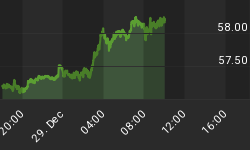Gold was up half a percent year-to-date through last Friday. This doesn’t sound very exciting, but over the same period, the S&P 500 Index was in the red—the first time in nearly a decade that stocks have been negative for the year through the beginning of May. The yellow metal is doing the one thing for which many investors have it in their portfolio—namely, it’s trading inversely to the market. This highlights its longstanding role as an attractive diversifier and store of value.

(Click to enlarge)
Gold has been under pressure from a strengthening U.S. dollar, and May has historically delivered lower prices. As I’ve pointed out before, this makes it an ideal entry point in anticipation of a late summer rally before Diwali and the Indian wedding season, during which gifts of gold jewelry are considered auspicious. Demand in China for the remainder of the year also looks promising.
India Gold Demand Weakened, but a Healthy Monsoon Could Help Reserve That
India’s demand for gold jewelry in the first quarter was down 12 percent from the same period last year, according to the latest report from the World Gold Council (WGC). Consumption fell to 87.7 metric tons, compared to 99.2 tons in the first three months of 2017. Contributing to this weakness was the fact that there were fewer auspicious days in the first quarter than in the same period of the past three years, according to the WGC.
However, this followed a monumental fourth quarter 2017, when gold demand in the world’s second-largest consumer was 189.6 metric tons—an all-time record—so a decline was expected.
Looking ahead, it’s estimated that India will have a “normal” monsoon season this summer. This is good news for gold’s Love Trade. A third of India’s gold demand comes from rural farmers, whose crop revenues depend on the rains from a healthy monsoon. When the subcontinent experiences a drought, as it did in 2014 and 2015, gold consumption suffers. Related: Five Deals To Watch This Week
The India Meteorological Department (IMD) reports that its forecasts suggest “maximum probability for normal monsoon rainfall” and “low probability for deficient rainfall during the season.”
Chinese Bullion Demand Off to a Good Start in 2018
In China, the world’s largest importer of gold, jewelry demand rose 7 percent in the first quarter to 187.7 metric tons, a three-year high. According to the WGC, Chinese retailers are working on improving the customer experience, providing consumers with “a more holistic retail solution.” The industry is expecting a strong 2018 after a relatively subdued 2017.
Except for a weak February, demand so far this year has been particularly strong, with monthly withdrawals from the Shanghai Gold Exchange (SGE) above the two-year average of 170 metric tons. April represented the third straight month of rising demand. Withdrawals were 28 percent higher than in the same month in 2017, according to veteran precious metals commentator Lawrie Williams.

(Click to enlarge)
Williams writes that fears of a potential trade war with the U.S. could be driving Chinese investors into safe haven assets, including gold bars and coins. Indeed, the WGC reports that bullion demand in the first quarter finished at 78 metric tons, above the three- and five-year averages.
I believe this all bodes well for the Love Trade going forward, meaning it might be an opportune time for investors to consider increasing their exposure to gold and gold mining stocks. As always, I recommend a 10 percent weighting, with 5 percent in bars, coins and jewelry, and 5 percent in high-quality gold stocks, mutual funds and ETFs.
By Frank Holmes
More Top Reads From Safehaven.com:

















